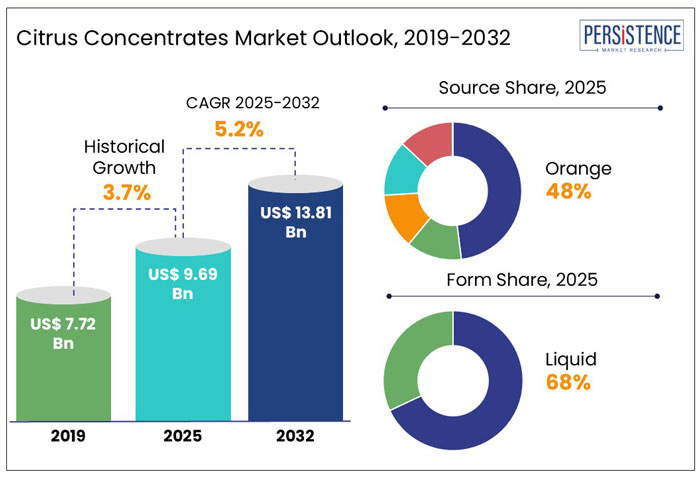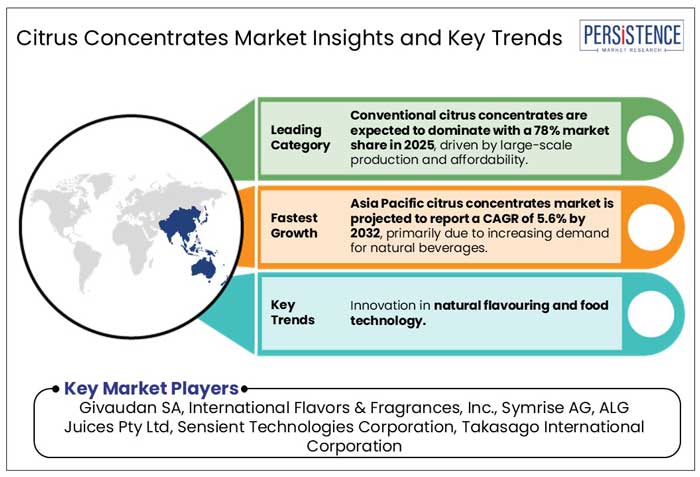Industry: Food and Beverages
Published Date: March-2025
Format: PPT*, PDF, EXCEL
Delivery Timelines: Contact Sales
Number of Pages: 167
Report ID: PMRREP26845
The global citrus concentrates market size is anticipated to rise from US$ 9.69 Bn in 2025 to US$ 13.81 Bn by 2032. It is projected to witness a CAGR of 5.2% from 2025 to 2032.
Citrus concentrates are in demand due to their versatility, natural flavor, and nutritional benefits. They are widely used in juices, carbonated drinks, confectionery, and dairy products, with orange and lemon concentrates leading the market.
The global fruit juice industry consumes over 40% of citrus concentrates, driven by consumer preference for natural and vitamin-rich beverages. In 2024, the U.S. and European brands saw a rise in citrus-based functional beverages, aligning with trends toward health-conscious consumption.
Companies like PepsiCo and Tropicana are launching low-sugar citrus drinks, further boosting demand for customized, high-quality citrus concentrates in various food sectors.

Key Highlights of the Citrus Concentrates Market
|
Global Market Attributes |
Key Insights |
|
Citrus Concentrates Market Size (2025E) |
US$ 9.69 Bn |
|
Market Value Forecast (2032F) |
US$ 13.81 Bn |
|
Projected Growth (CAGR 2025 to 2032) |
5.2% |
|
Historical Market Growth (CAGR 2019 to 2024) |
3.7% |
Health-Conscious Trends Fuels Demand for Citrus Concentrates Amid Pandemic
According to Persistence Market Research, the global citrus concentrates market experienced a CAGR of 3.7% from 2019 to 2024. The demand and production of citrus concentrates surged, largely driven by the COVID-19 pandemic, which boosted consumer interest in immune-boosting foods rich in vitamin C.
According to U.S. Department of Agriculture, global citrus fruit production reached nearly 150 million tons in 2020, with oranges leading at 75 million tons, followed by lemons and limes at 22 million tons.
The juice industry alone absorbed 40% of global orange production, with a significant rise in exports from Brazil, Mexico, and Spain, based on the EU Citrus Annual 2024. The citrus production in Europe grew 12% in 2020, while the U.S. saw a 9% rise in citrus product sales.
China and India also expanded citrus processing facilities to meet rising domestic and export demand. The observed period saw record-high orange juice consumption, with production facilities in Brazil increasing exports by 17% in 2021.
As consumers prioritized health-conscious beverages, brands like Tropicana and Minute Maid launched new citrus-based products, further fueling market expansion.
Government Initiatives Promotes the Production of Healthy Functional Products
In the estimated timeframe from 2025 to 2032, the global market for citrus concentrates is likely to showcase a CAGR of 5.2%. Rising health awareness and acknowledgment of the nutritional advantages of citrus-based products are generating market prospects for functional beverages. Because they are high in vitamin C, flavonoids, and antioxidants, citrus fruits are a staple in beverages that increase immunity.
Research indicates that functional fruit-based beverages represent 20 to 30% of the global health drink market, with citrus juices at the forefront due to their antimicrobial and anti-inflammatory properties. Recognizing these benefits, several governments worldwide have implemented innovative initiatives to enhance the production of citrus fruits. For instance,
Consumer preference for natural and fortified beverages over artificial energy drinks is predicted to drive growth in global sales for citrus-based functional drinks. Sustainable methods for valuing citrus waste encourage a circular economy, which boosts the market's capacity for innovation and sustainability.
Growth Driver
Rise in Food Processing Industry Promotes Innovation in Flavoring
The use of citrus concentrates in flavoring and ingredient applications is growing in the food processing sector, particularly in the summer when demand for beverages with citrus flavors is at its highest.
In the summer season, citrus-flavored beverages account for 40% of the worldwide juice and flavored drink industry, led by companies such as The Coca-Cola Company, PepsiCo, and Nestlé. Based on the market survey, Coca-Cola's Simply Orange and Minute Maid citrus juice brands continue to dominate in 2025, with PepsiCo's Tropicana being a strong competitor in the premium juice sector.
In addition to non-alcoholic beverages, the alcoholic beverage industry is also utilizing citrus concentrates to create flavored cocktails and mixers, which helps to expand the market. For example, companies like Diageo and Pernod Ricard incorporate citrus-based ingredients in their ready-to-drink cocktails and flavored spirits.
As businesses like Symrise and Firmenich create cutting-edge citrus extracts for functional beverages, the demand is also being driven by the expansion of natural and organic citrus tastes. The demand for citrus concentrate is anticipated to continue growing in food and beverage applications as health-conscious customers look for organic flavor alternatives.
Market Restraining Factor
Climate Change and Agricultural Challenges Impact Citrus Production
The production of citrus products is being impacted by climate change and agricultural difficulties, which is causing supply and price instability in the demand for citrus concentrates. Citrus harvests in important producing nations like Brazil, the U.S. (Florida), and Spain have been affected by extreme weather conditions including frost, excessive rains, and droughts. Unpredictable rainfall patterns caused a 10% drop in orange output in 2022 in Brazil, the country that exports the most orange juice across the world.
Citrus diseases and infections pose a threat to supply chains, with citrus greening disease (HLB) causing over 75% reduction in Florida's orange production over two decades, and projected to reach its lowest level in 80 years in 2023, as per USDA.
As manufacturers face raw material shortages, companies like PepsiCo’s Tropicana and Coca-Cola’s Minute Maid are struggling to maintain steady supplies. Industry stakeholders are now focusing on disease-resistant crops and climate-adaptive farming to stabilize production and pricing.
Key Market Opportunity
Integration of Citrus Concentrates in Personal Care and Pharmaceuticals Improves Applications
Citrus concentrates are essential to the personal care and pharmaceutical sectors because of their anti-inflammatory, antibacterial, and antioxidant qualities. Businesses such as International Flavors & Fragrances (IFF), Symrise AG, and Givaudan are using citrus extracts in cosmetic products, dietary supplements, and functional meals. The rising demand for natural cosmetics and health products is predicted to fuel growth in the global citrus oil production.
In the personal care industry, brands like L’Oréal and Unilever are using citrus-based antioxidants in skin-brightening serums and shampoos. In pharmaceuticals, companies like BASF and Cargill are utilizing citrus bioflavonoids in immune-boosting supplements and vitamin C formulations. Citrus concentrates also dominate the juice and beverage sector, with major players like Tropicana (PepsiCo) and Minute Maid (Coca-Cola) expanding citrus-based product lines to meet consumer preferences for natural and health-enhancing beverages.
Source Insights
Orange is the Best Source of Healthy Concentrates for the Industry
In 2025, based on source, orange concentrates are expected to hold a market share at 48%, as they remain the primary ingredient in fruit juices, flavored water, and bakery products. Leading companies like Louis Dreyfus Company (LDC), Citrosuco, and Cutrale dominate the global orange concentrate supply chain, with Brazil and the U.S. being the top producers.
Following that, lemon & lime concentrates, projected to account for 24% of the market, are widely used in carbonated drinks, sauces, and health supplements. Companies like Kerry Group and Dohler Group focus on lemon-based functional beverages, capitalizing on their high vitamin C content.
Grapefruit concentrates, holding 15% market share, are gaining traction in sports drinks and dietary supplements, with Citromax Group and Lionel Hitchen leading innovations in grapefruit extract formulations. The demand for citrus concentrates is further fueled by clean-label and natural ingredient trends, shaping the future of the industry.
Nature Insights
With Large-Scale Manufacturing of Conventional Concentrates Fuels Production
The global citrus concentrates market is segmented into organic and conventional categories, with conventional citrus concentrates expected to dominate in 2025, holding a 78% market share. Large-scale manufacturing, affordability, and accessibility make conventional citrus concentrates popular. Major beverage brands and food producers throughout the world are supplied by companies like Louis Dreyfus Company (LDC), Citrosuco, and Cutrale, who dominate the traditional category. Conventional citrus fruits are still mostly produced in the U.S. and Brazil, which guarantees a consistent supply for processing.
On the other hand, organic citrus concentrates are gaining traction, projected to hold 22% of the market in 2025, driven by clean-label trends and rising demand for chemical-free ingredients. Companies like Dohler Group, SVZ International, and Lemon Concentrate S.L. are expanding their organic product lines to meet the growing preference for non-GMO, pesticide-free citrus concentrates. The adoption of organic food and beverages, in Europe and North America, continues to drive the segment's growth.

Europe Citrus Concentrates Market
Rise in Production and Import of Citrus Produce in Europe Boost Market
Europe’s booming tourism industry and expanding food service sector are driving the growth of the citrus concentrates market, with demand surging for natural ingredients in beverages, desserts, and culinary applications. Thus the industry in Europe is estimated to hold a market share of 39% in 2025. The European Union (EU) is one of the largest consumers of citrus-based products, particularly in Germany, the U.K., France, and Italy, where citrus juices are widely used in the HoReCa sector.
According to the USDA Citrus Annual Report (2024), the EU’s orange juice production is estimated at 51,860 metric tons for the 2023 to 24 season, reflecting the increasing use of orange concentrates in the food and beverage industry.
Additionally, imports of citrus juices from Brazil, Mexico, and South Africa have grown to meet rising demand. CBI reports that Europe accounts for 40% of global citrus juice imports, emphasizing its reliance on high-quality citrus concentrates.
With health-conscious consumers favoring vitamin-rich beverages, European food manufacturers and beverage brands are incorporating organic and functional citrus-based drinks, further boosting market growth.
North America Citrus Concentrates Market
Trend of Healthy RTD Products in North America Presents Investment Opportunities
The citrus concentrates market in North America is projected to hold a 22% market share in 2025. North America is estimated to report a CAGR of 4.7% through 2032. The region's growth is driven by increasing consumer demand for natural and functional beverages, in the U.S. and Canada. The rising trend of clean-label and organic citrus-based products has led companies like PepsiCo (Tropicana), Florida’s Natural Growers, and Citrosuco North America to expand their portfolios in the region.
With Florida's robust citrus output, the U.S. controls the operations in North America, making up for a substantial contribution to the supply of orange and grapefruit concentrates. Citrus harvests have been impacted by citrus greening disease, like HLB, though, and producers are now importing citrus concentrates from Mexico and Brazil to keep up with the rising demand.
As concentrates are used in RTD beverages, cocktails, and functional drinks, thus, is a high demand for lemon and lime concentrates in the U.S. The demand for citrus concentrate in North America is expected to grow steadily with more investments in environmentally friendly citrus production and processing techniques.
Asia Pacific Citrus Concentrates Market
Growing Demand for Natural Beverages in Food Processing Industry of Asia Pacific
Asia Pacific citrus concentrates market is expected to experience a CAGR of 5.6% through 2032, driven by rising demand for natural beverages and expanding food processing industries in China, India, Japan, and Southeast Asia.
China, the largest citrus producer globally, accounts for 25% of global citrus fruit production, while India and Vietnam are expanding citrus cultivation to meet rising domestic and export demand. Beverage manufacturers are launching organic and fortified citrus drinks, fueling market expansion. The rapid growth of e-commerce and retail distribution networks further accelerates the adoption of citrus concentrates in the region.
Producers are diversifying their product portfolios by incorporating citrus flavors into various items, including food and beverages, cleaning products, and pharmaceuticals. As social media trends enhance the consumer base for these products, some beverage producers are partnering with social media influencers and movie studios to launch innovative promotional campaigns.
Manufacturers in the citrus concentrate market have strategically located their production facilities near citrus-producing regions to source fresher raw materials and provide superior quality products with a longer shelf-life.
Key Industry Developments
|
Report Attributes |
Details |
|
Historical Data/Actuals |
2019 - 2024 |
|
Forecast Period |
2025 - 2032 |
|
Market Analysis Units |
Value: US$ Bn, Volume: Tons |
|
Geographical Coverage |
|
|
Segmental Coverage |
|
|
Competitive Analysis |
|
|
Report Highlights |
|
|
Customization and Pricing |
Available upon request |
By Source
By Form
By Nature
By End Use
By Region
To know more about delivery timeline for this report Contact Sales

The global market for citrus concentrates has a value of US$ 8,911.80 Mn in 2023.
The global market for citrus concentrates has a value CAGR of 5.28% from 2018-2022.
The global market for citrus concentrates has a value of US$ 14,795.26 Mn in 2033.
The global market for citrus concentrates has a value CAGR of 5.2% from 2023-2033.
The top players hold more than 15-20% of the market share. They include Companies such as Dohler, Prodalim Group, Louis Dreyfus Company, Citrosuco, Citromax, Levy Group International are some of the major players operating in the global citrus concentrates market.